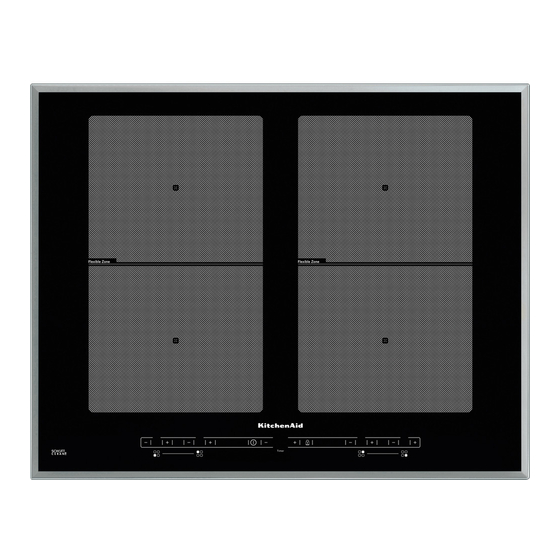
Table of Contents
Advertisement
Quick Links
Advertisement
Table of Contents

Summary of Contents for KitchenAid KHID4 65510
- Page 1 Instructions for use...
-
Page 3: Table Of Contents
Installation diagrams Important safety instructions Safeguarding the environment Eco Design Declaration Before use Using existing pots and pans Recommended pan base diameters Installation Electrical connection Instructions for use Cleaning Troubleshooting guide Noises made by the hob After-Sales Service Power level table Functions table... -
Page 4: Installation Diagrams
Installation diagrams 235 mm 235 mm R = Min. 6,5 mm Max. 8 mm Min. 50 mm R = 11,5 mm 483 mm 490 mm 560 mm R = 11,5 mm 6 mm R = Min. 6,5 mm Max. 8 mm Min. - Page 5 Installation diagrams...
-
Page 6: Important Safety Instructions
These instructions are also available on our website: docs.kitchenaid.eu IMPORTANT SAFETY INSTRUCTIONS YOUR SAFETY AND THAT OF OTHERS IS VERY IMPORTANT This manual and the appliance itself provide important safety messages, to be read and always observed. This is the danger symbol, regarding safety, warning of potential risks to users and others. - Page 7 - Do not pull the appliance’s power cable. - The electrical parts must not be accessible to the user after installation. - The appliance is designed solely for domestic use for cooking food. No other use is permitted (e.g. heating rooms). The Manufacturer declines any liability for inappropriate use or incorrect setting of the controls.
- Page 8 - Metallic objects such as knives, forks, spoons and lids should not be placed on the hob surface since they can get hot. - After use, switch off the hob element by its control and do not rely on the pan detector (only for appliances with glass surface). Disposal of household appliances This product is built from recyclable or reusable materials.
-
Page 9: Safeguarding The Environment
Safeguarding the environment Disposal of packaging materials Energy saving tips The packaging material is entirely recyclable and For optimum results, observe the following advice: marked with the recycling symbol ( ). Do not • Use pots and pans whose bottom diameter is dispose of the various packaging materials equal to that of the cooking zone. -
Page 10: Using Existing Pots And Pans
Using existing pots and pans Use a magnet to check whether pots or pans are suitable for use on the induction hob: pots are unsuitable if they cannot be magnetically detected. Ensure pots have a smooth bottom, otherwise they may scratch the hob’s glass ceramic surface. Check dishes. -
Page 11: Electrical Connection
Electrical connection WARNING Disconnect the appliance from the mains power supply. Installation must be carried out by a qualified electrician who is fully aware of current safety and installation regulations. The manufacturer declines all liability for injury to persons or animals and for damage to property resulting from failure to observe the regulations provided in this chapter. -
Page 12: Instructions For Use
Instructions for use Control panel description The control panel is equipped with touch controls: to use them, just press the corresponding symbol (a light touch is sufficient). Timer Power Power management Control panel lock/Special function/ management step 1 On/Off Power management step 2 and 4 step 1 Cooking zone controls and corresponding display Switching the hob ON/OFF... - Page 13 Instructions for use Timer The timer can be used to set the cooking time for a maximum of 99 minutes (1 hour and 39 minutes) for all the cooking zones. Select the cooking zone to be used with the timer, press the timer and a beep signals the function (see figure).
- Page 14 Instructions for use “Power management” (Function where it is available) Thanks to the “Power management” function, the user can set the maximum power the hob can reach, as required. This setting is possible at any time and is maintained until the next change. By setting the required maximum power, the hob automatically adjusts distribution in the various cooking zones, ensuring that this limit is never exceeded;...
- Page 15 Instructions for use Flexible zone Where present, this function allows the cooking zone to be used as two separate zones or as a single extra large zone. It is perfect for oval, rectangular and elongated pans (with maximum base dimensions of 38x23 cm) or more than one standard pan in the same time.
-
Page 16: Cleaning
Cleaning WARNING Never use steam cleaners. Before cleaning, ensure that the cooking zones are switched off and that the residual heat indicator (“H”) is not displayed. IMPORTANT: Do not use abrasive sponges or scouring pads. Their use could eventually ruin the glass. •... -
Page 17: After-Sales Service
After-Sales Service Before contacting the After-Sales Service 1. See if you can eliminate the problem on your own by referring to the “Troubleshooting guide”. 2. Turn the hob off and on again to check if the problem has been eliminated. If the fault persists after the above checks, contact the nearest After-Sales Service. -
Page 18: Power Level Table
Power level table Level use Power level Type of cooking (indicating cooking experience and habits) Ideal for rapidly increasing the temperature of Boost Fast heating food to fast boiling in the case of water or rapidly heating cooking liquids Max. power Ideal for browning, starting to cook, frying Frying - boiling... -
Page 19: Functions Table
Functions table Function Description of automatic functions Identifies a power level that is suitable for simmering long-cooking recipes. Suitable for cooking tomato sauce, ragu, soups, minestrone, maintaining a constant cooking level; ideal for cooking Simmering in a bain-marie (creams) and regenerating cooked food. Prevents food from boiling over or sticking to the bottom and burning, as often happens with these recipes. - Page 20 WHIRLPOOL EUROPE s.r.l. Socio Unico Printed in Italy 400010909884...













Need help?
Do you have a question about the KHID4 65510 and is the answer not in the manual?
Questions and answers